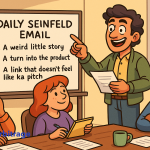This blog provides an introduction to the art of using scarcity in copy to drive conversions. This blog would be useful for content writers, marketers, strategists, and small brand or startup owners who want to use this super tool to sell more effectively.
Table of Contents
Introduction
I remember coming across this weird news at the time of the Pandemic. Many US supermarkets ran out of toilet paper of all things.
People believed that the shops would close soon and they would not have access to any more toilet paper, ever. Target and Costco became battlegrounds over this essential.
I remembered the trivia because frankly, I found it funny. However, it is also interesting because it highlights exactly how scarcity works.
We have all done the same thing as those Americans at different points in our lives. We have bought things because they were “the last ones left”, “clearing out soon”, bought tickets to events because “seats were filling out fast!” etc.
We don’t want to miss out. So we click.
That’s scarcity. And it’s powerful. And it drives conversion like crazy!
When something is scarce, our brain flips into a different mode:
From “Should I buy this?” to “What if I miss this forever?”
In this blog, I will break down how you, can weaponize scarcity to write irresistible copy—across emails, WhatsApp campaigns, and more.
We will cover the psychology of scarcity (and why it works,), super scarcity frameworks that actually convert, Indian brand examples where scarcity worked like a charm, and some really cool templates.
Intrigued?
Let’s start.
You are going to miss out: the psychology behind scarcity.
Scarcity triggers one of the most primal fears hardwired into our brain: FOMO (Fear of Missing Out).
It activates urgency, heightens desire, and lowers logical resistance. Because of three peculiar brain functions, content writers like us can leverage FOMO to clear out stock.
Take a look at this diagram to know what they are and how they act.
These are reasons that make fashion and beauty brands run flash sales, why e-commerce platforms display “Only 3 left” ” and why online courses close enrollments with countdown timers.
When you write scarcity-based copy well, you short-circuit the overthinking brain.
And that means faster conversions.
But is all scarcity the same? Every blinking neon sign in the online bazaar, screaming for the audience to “hurry”, “rush” and “get it” – do they all fall neatly into the same compartment?
Not at all.
3 types of scarcity you need to master
Time-based scarcity: “Offer ends tonight.”
This is the classic one, the Marilyn Monroe of scarcity techniques. Here availability is restricted to a specific time frame—24 hours, 72 hours, 7 days.
This technique works well for flash sales, webinar registrations, or course launches.
Examples:
- “This 60% off SkillArbitrage offer disappears in 24 hours.”
- “Enroll before Friday to get the bonus AI writing toolkit.”
Why it works: The ticking clock builds pressure and makes the running out of time a visible reality. People don’t want to “miss” the deadline.
Quantity-based scarcity: “Only 7 seats left.”
Here, you limit how many people can buy—seats, products, slots. It makes the offer feel exclusive.
Examples:
- “Only 3 mentorship slots left this month.”
- “We’re down to the last 5 copies of the premium edition.”
Why it works: People feel the competition. It activates urgency and exclusivity, everyone wants those last 7 seats.
Access-based scarcity: “Not available to everyone.”
This one is subtle and powerful and more popular among niche products or events, remember clubs that launch with “by invitation only” events?
You restrict who can access the offer—based on application, location, or qualification. This builds an aura of exclusivity and mystery piquing interest.
Examples:
- “Invite-only event for freelancers earning ₹1L/month.”
- “Available only for returning SkillArbitrage learners.”
Why it works: Humans crave what they can’t have. You turn the product into a symbol of status.
I am sure that by now, a chain of similar copies you have spotted is running through your mind.
These techniques are used extensively by e-commerce brands, Saas, ed-tech, grocery and food delivery services, etc.
Brands that nail scarcity
Let’s break down how brands use scarcity to win.
E-commerce pushing sale days
Their whole campaign is built around limited time and limited stock scarcity.
Every product page screams:
“Only 2 left in stock. Hurry!”
“Next deal unlocks in 4 hours.”
“Offer valid till midnight!”
Why it works: The fear of missing out + the thrill of catching a “deal” creates a buying frenzy.
Copywriting takeaway: Use countdowns + low-stock alerts + event-based urgency.
Food delivery apps using time scarcity
Food delivery apps like Swiggy and Zomato often use scarcity in hyper-local ways to build relevance. You’ll see:
“Only 3 restaurants left with this deal.”
“Flat 60% off – valid for the next 25 mins.”
Why it works: Time limits plus food cravings = instant orders.
Copywriting takeaway: Combine scarcity with craving or emotion to intensify urgency.
Ed-tech email launches
Popular ed-tech brands use email sequences with countdowns, bonuses that disappear, and “doors closing” timers.
Example email subject lines:
“Last 24 hours to get this.”
“After tonight, it’s gone.”
“This bonus expires at midnight.”
Copywriting takeaway: Scarcity works best when layered with bonuses or price increases.
How to write scarcity-based copy (with template)
Here’s a plug-and-play formula you can use to write scarcity copy anytime, about any brand:
Scarcity copy formula:
- State the offer clearly.
- Introduce the limitation (time/quantity/access).
- Add a consequence of missing out.
- Give a clear call-to-action.
Example of an upskilling course:
Header:
“The last chance to enroll — closes in 24 hours!”
Body copy:
“This is your final reminder: Enrollment for the Freelance Content Domination Bootcamp shuts down at midnight. After that, you won’t get access to the bonus AI writing masterclass, the ₹2,000 discount, or the free one-on-one coaching.”
“There are only 11 seats left. Don’t miss this.”
“[Enroll now]”
WhatsApp example for a lipstick brand launch
“New launch alert: Our cruelty-free “Velvet Matte” lipstick is now live!”
“But here’s the catch—only 500 units are available!
First come, first served.”
“Get yours before they’re gone.
[Shop Now]”
Both these messages use the four steps given at the start of the segment: they state the offer fearlessly, use time scarcity, add the consequences of missing out, and add urgency in the call to action.
Remember, scarcity triggers work best when they are layered on top of each other.
Let’s break down a full campaign using stacked scarcity and bonuses to sell.
Campaign breakdown: scarcity x bonuses = magic
This is a launch strategy that uses stacked scarcity.
Here’s a basic brief:
Campaign: Launch of a new upskilling course on LinkedIn content writing.
Goal: Enroll users in a premium online course teaching how to create compelling LinkedIn content.
Target Audience: Professionals, marketers, and freelancers looking to boost their personal brand on LinkedIn.
Tactics used:
Day 1-2: Announce early bird pricing (time-based scarcity)
Tactic: Offer a discounted price for a limited time to incentivize quick sign-ups.
Example:
- Email Subject: “Early Bird: 40% Off Our LinkedIn Content Writing Course (48 Hours Only!)
- Content: “Be among the first to join our LinkedIn Content Writing Mastery Course at INR 149 (regular price:INR 249). This exclusive early bird deal expires in 48 hours on May 11, 2025, at 11:59 PM IST. Learn to craft posts that get 10x engagement and build your brand!”
- Social Post (LinkedIn/X): ” Launching our LinkedIn Content Writing Course! Grab the early bird price of INR 149 (INR 100) before it’s gone in 48 hours. Only for the first movers! [Link to landing page]
- Why it works: The 40% discount creates a financial incentive (bonus), and the 48-hour deadline (time scarcity) pushes immediate action.
Day 3: Add a bonus that disappears in 24 hours (bonus-based urgency)
Tactic: Introduce a high-value bonus to sweeten the deal, but make it available for only 24 hours.
Example:
- Email Subject: “24-Hour Bonus: Get Our LinkedIn Profile Optimization Guide FREE!”
- Content: “Enroll in the LinkedIn Content Writing Mastery Course by 11:59 PM IST tonight, and you’ll get our exclusive LinkedIn Profile Optimization Guide (valued at INR79) as a free bonus. This guide shows you how to rank higher in LinkedIn searches and attract more connections. Don’t miss out—this bonus disappears in 24 hours!“
- Social Post (LinkedIn/X): “Only 24 hours left to get a FREE LinkedIn Profile Optimization Guide when you join our Content Writing Course! Enroll now to level up your LinkedIn game. [Link]“
- Why it works: The bonus adds perceived value, and the 24-hour window (time scarcity +FOMO) creates urgency to act before losing the extra perk.
Day 4: Announce only 25 seats left (quantity-based scarcity)
Tactic: Highlight limited availability to create fear of missing out (FOMO).
Example:
- Email Subject: “Only 25 Spots Left in Our LinkedIn Writing Course!”
- Content: “Demand is high, and we’re down to just 25 seats in the LinkedIn Content Writing Mastery Course. Don’t wait—these spots will be gone soon. Enroll now at INR 149 (early bird pricing ends tomorrow) and secure your place to master LinkedIn content!”
- Social Post (LinkedIn/X): ” Only 25 seats remain in our LinkedIn Content Writing Course! Don’t miss your chance to learn how to create viral posts. Grab your spot before they’re gone! [Link]”
- Why it works: Limiting seats taps into FOMO, making prospects feel they need to act fast to secure access.
Day 5: Final 12-hour countdown (absolute urgency)
Tactic: Create a hard deadline with a short window to drive last-minute sign-ups.
Example:
- Email Subject: “12 Hours Left: Don’t Miss the LinkedIn Writing Course!”
- Content: “This is it—the cart closes in 12 hours at 11:59 PM IST on May 14, 2025. Join the LinkedIn Content Writing Mastery Course now for INR 149 and learn to write posts that grow your network and influence. After tonight, this offer is gone for good!”
- Social Post (LinkedIn/X): ” FINAL 12 HOURS to join our LinkedIn Content Writing Course! Don’t let this chance to skyrocket your LinkedIn presence slip away. Enroll now! [Link]”
- Why it works: The short 12-hour window creates intense urgency, pushing procrastinators to act before the opportunity vanishes.
5. Day 6: “Cart Closed” email (Loss Confirmation)
Tactic: Confirm the offer is no longer available to reinforce scarcity and encourage future action.
Example:
- Email Subject: “The LinkedIn Writing Course Is Officially Closed”
- Content: “The cart for the LinkedIn Content Writing Mastery Course is now closed. If you missed out, don’t worry—join our waitlist for the next cohort and get first dibs on future offers. Stay tuned for more ways to level up your LinkedIn skills!”
- Social Post (LinkedIn/X): ” The LinkedIn Content Writing Course is closed! Missed it? Join our waitlist to be the first to know about the next launch. [Link to waitlist]”
- Why it works: Confirming the loss reinforces the scarcity mindset, making prospects more likely to act quickly on future offers.
Why this campaign works (scarcity x bonuses = magic)
- Scarcity: Each day ramps up urgency (time, quantity, absolute deadlines), tapping into FOMO and pushing action.
- Bonuses: The limited-time bonus adds value, making the offer feel like a no-brainer.
- Stacked Approach: Layering tactics (early bird → bonus → limited seats → final countdown) keep momentum high and prevent prospects from delaying.
Projection: Spikes in sales every time a scarcity angle is layered in.
Takeaway: Don’t rely on one form of scarcity. Stack multiple types for compounding urgency.
In the above examples, you must have noticed that specific words are used to trigger scarcity.
Here’s a useful list of such words.
List of words that trigger scarcity instantly
Use these in your headlines, CTAs, and hooks to make your copy feel time-sensitive:
- Last chance
- Offer ends tonight
- Running out fast
- Only X left
- Final call
- Limited-time
- Once it’s gone, it’s gone
- Seats filling fast
- Access closes soon
- Not for everyone
- Invite-only
- Exclusive batch
Pro tip: Pair these words with numbers and specificity for maximum impact. Example: “Only 2 spots left” > “Hurry, register now”
Final thoughts: scarcity is not pressure. It’s clarity.
Many brands shy away from using scarcity because they find it too cheap and salesy.
Let me put your mind at ease. You are not “tricking” your audience with scarcity.
You are helping them make a decision—before the window closes.
If your offer is genuinely valuable…
If the deadline is real…
If the seats are limited…
Then saying that upfront is not pressure. It’s clarity.
And, the better you get at using scarcity ethically and effectively, the more your content will convert.
Scarcity is your best friend when:
- Your audience is hesitating.
- Your offer has a deadline, cap, or exclusivity.
- You want faster conversions and less ghosting.
Master this one concept and your copy won’t just be read—it’ll be acted on.
Ready to try this in your next campaign? Pick a product or service you’re selling this week, identify one genuine scarcity trigger, and write a headline and CTA using the formula above.
Send it. Watch the magic happen.
FAQ
1. What’s the difference between false urgency and strategic scarcity in copy?
Answer: False urgency is manipulative—like a countdown timer that resets when refreshed. Strategic scarcity is rooted in truth: limited seats, expiring bonuses, or seasonal stock. The key is to tie scarcity to real constraints (inventory, time, capacity), which builds trust while driving action.
2. How can I use scarcity without sounding pushy or salesy?
Answer: The trick is to frame scarcity as a service, not pressure. Instead of saying “Hurry up!” try:
“Only 3 slots left—just sharing in case this aligns with your goals.”
Subtle language, transparency, and empathy can make scarcity feel helpful rather than aggressive.
3. How do you write scarcity copy when you don’t actually have limited stock or time?
Answer: Scarcity doesn’t have to be physical—it can be emotional or experiential. For instance:
“This is the last time we’ll offer 1:1 feedback with the course.”
“Next cohort starts in 90 days—this window won’t return soon.”
Use content, access, or opportunities as the scarce element.
4. How can I use AI tools like ChatGPT to write scarcity-driven copy without sounding robotic?
Answer: AI tools like ChatGPT can be trained to write nuanced, emotional scarcity copy if you provide the right prompts. Try inputs like:
“Write a friendly, scarcity-based headline for an early-bird course offer using loss aversion psychology”
Or
“Generate 3 urgent but non-salesy email subject lines for a limited-time bonus.”
Refine outputs with real human insight to keep the tone natural and brand-aligned.
5. What are examples of scarcity copy that perform well in emails vs. landing pages?
Answer:
Emails: Focus on personal urgency — “Only 2 days left to claim your spot—just a heads-up.”
Landing Pages: Highlight social scarcity and proof — “Last 5 seats taken in under 24 hours.”
Tailor scarcity to the reader’s mindset at that stage of the funnel.
6. How do I test which type of scarcity—time-based, quantity-based, or access-based—works best?
Answer: Use A/B testing frameworks. Run the same core offer with different scarcity levers:
Version A: “Offer expires in 48 hours.”
Version B: “Only 10 left.”
Version C: “Exclusive to our email list.”
Track conversions, open rates, and click-throughs to identify what your audience responds to.
7. How can freelancers or personal brands use scarcity without having products or inventory?
Answer: Sell your time or availability as a scarce commodity:
“I’m opening 3 slots for 1:1 coaching this month.”
“Only taking on 2 new clients for Q3.”
This creates exclusivity around your expertise, not a product.
8. Can scarcity backfire or reduce trust in long-term relationships with customers?
Answer: Yes—especially if it’s overused or feels dishonest. Scarcity must be earned and respected. If every email screams “Last chance!” you lose credibility. Instead, use it selectively and pair urgency with value to maintain trust.
9. What are some lesser-known phrases or framing techniques to trigger scarcity subtly?
Answer: Instead of cliché phrases like “limited time only,” try these:
“We’re capping this at 20 to ensure quality.”
“Enrollment closes Sunday—this is our last guided cohort for the year.”
“We won’t run this format again.”
Subtle, narrative-led scarcity often outperforms overt urgency.







 Allow notifications
Allow notifications
